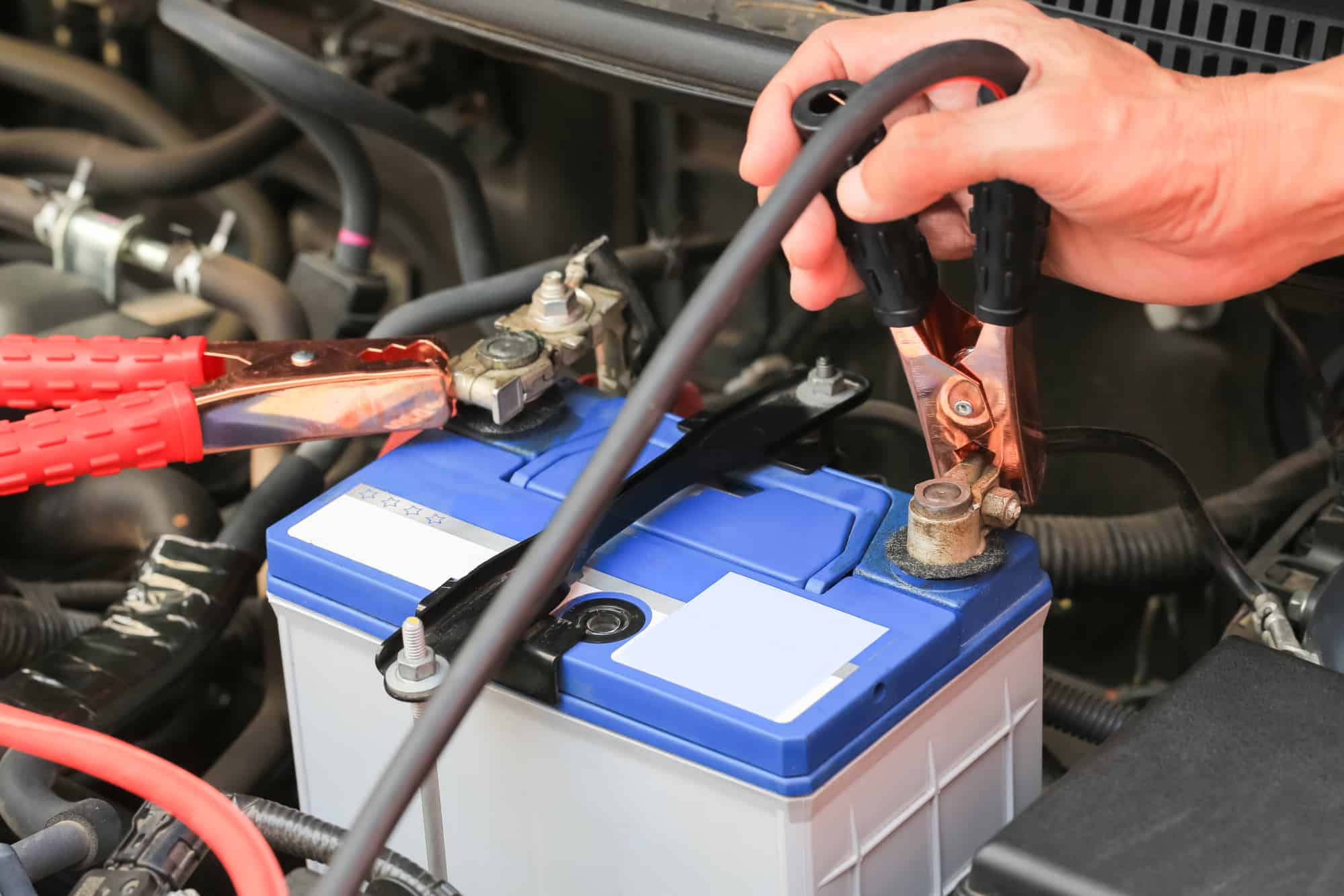A flashing check engine light is a source of frustration for any driver. It’s a warning light that indicates something is wrong with the vehicle, but it doesn’t always provide clear information about what that something might be. One possible cause of a check engine light is a dead or dying battery.
When your vehicle’s battery is no longer charging properly, it may not have enough power to properly operate all of the vehicle’s electrical systems when the engine is running. This can cause a variety of issues, including problems with the engine, its sensors or other auxiliary systems, all of which can trigger the check engine light.
A weak battery is not always the cause of a check engine light, and other factors may be at play. So in this article, we will explore the connection between a weak battery and a check engine light. We will also discuss other possible causes of a check engine light, including issues with the fuel system, oxygen sensor, and catalytic converter.
Can A Dead Battery Cause The Check Engine Light To Come On?
A dead or dying car battery can cause the check engine light to come on if the battery is causing problems, as it can no longer provide the necessary power to the various parts of your car when it’s running.
The check engine light is a warning light that illuminates on the dashboard of a vehicle. It is designed to alert you, the driver of potential issues with the vehicle’s engine or other systems in your car.
The check engine light is part of the onboard diagnostics (OBD) system in modern vehicles. This system constantly monitors the vehicle’s engine and emissions system for any issues or malfunctions.
When a problem is detected, the OBD system will store a diagnostic trouble code (DTC) in its memory and illuminate the check engine light.
There are a variety of issues that can trigger the check engine light, ranging from minor issues such as a loose gas cap to more serious problems such as a faulty oxygen sensor or catalytic converter.
Another possible cause is a bad alternator, as this can indirectly trigger the check engine light if the battery is dead or not charging properly.
Can a Weak Battery Cause the Check Engine Light?
The check engine light can turn on for a variety of reasons, but some of the most common causes include issues with the vehicle’s emissions system, such as a faulty oxygen sensor, catalytic converter, or gas cap.
Other potential causes include problems with the engine’s sensors, such as a faulty mass airflow sensor or a misfiring cylinder. The check engine light can also turn on if there is a problem with the vehicle’s fuel system, ignition system, or transmission. Battery Issues
Another, often overlooked possible cause of the check engine light turning on is a weak battery.
A weak battery is a common reason for a check engine light to come on, as it can cause a low voltage supply to the car’s ECU and trigger fault codes for faults that don’t exist.
This can also lead to a variety of issues, including difficulty starting the car, dimming headlights, and other electrical problems.
4 Reasons Why A Weak Battery Can Trigger The Check Engine Light
When a car is running, the battery primarily powers the vehicle’s electrical system, which includes the lights, radio, and other accessories. The battery also plays an important role in starting the engine and in supporting the alternator, which generates electricity to power the car’s electrical components and recharge the battery.
A weak battery can cause electrical gremlins in a vehicle’s many electrical systems, and this can lead to the ECU receiving out-of-range signals from sensors that can trigger the check engine light. Here are a few ways a weak battery can trigger the check engine light.
- The battery helps to stabilize the car’s electrical system by providing a steady supply of voltage and current, which helps to prevent voltage spikes and other electrical issues that can damage the car’s sensitive electronics. An undercharged battery won’t be able to meet the electrical demands of a car, and this can lead to a lack of adequate power for various electrical sensors and modules and sometimes the ECU.
- When a car’s battery is weak, it may not have enough power to fire the starter motor and to properly start the engine. This can trigger the check engine light if the engine is struggling to turn over and if there is a lack of fuel or power to ignite the spark plugs this can cause a misfire when the engine is trying to start.
- A weak battery can also cause an engine to misfire because of low fuel pressure, which can trigger the check engine light. This can happen if the battery is not providing a steady current to the fuel pump, which can lead to a drop in fuel pressure that adversely affects the amount of fuel getting into the engine cylinders.
- Another battery issue that can cause the check engine light to turn on is a faulty alternator. The alternator is responsible for charging the battery while the engine is running. If the alternator is overcharging or undercharging, the battery may not be charged enough to start the engine or to supply auxiliary power when driving.
- A corroded battery terminal can also cause a check engine light to come on because it can result in poor electrical connections and low voltage to the sensors in the vehicle. The sensors in a car rely on voltage as control, and if the voltage is low due to a corroded battery terminal, the sensors may register this as a problem and trigger the check engine light. Additionally, a corroded battery terminal can cause the car’s electrical system to malfunction, which can also trigger the check engine light.
Symptoms of a Weak Battery That Can Trigger The Check Engine Light
A weak battery can cause a variety of problems with your vehicle that may be intermittent. Here are some symptoms you may experience:
- Difficulty starting the engine: If the battery is weak, it won’t have enough power to start the engine and this can also trigger the check engine light.
- Dimming headlights: A weak battery may not be able to power the lights properly when the engine is off, causing your parking and interior lights to dim or flicker.
- Slow cranking: If the engine cranks slowly or takes longer than usual to start, it may be a sign of a weak battery.
- Electrical issues: A weak battery can cause electrical issues in the car, such as problems with the radio, power windows, or dashboard lights.
A weak battery can cause other problems in your vehicle, such as misfires due to low fuel pressure or damage to the alternator if it is constantly operating at a higher voltage output when trying to compensate for the bad battery cells.
It’s also important to note that extreme temperatures can affect the performance of your battery. In cold weather, a weak battery may not have enough power to start the engine. In hot weather, the battery may be overworked and become damaged.
How to Fix the Check Engine Light and Dead Battery
If you suspect that a weak battery is causing the check engine light to come on, there are a few steps you can take to fix the issue.
You should start by running an OBD diagnostic to see if there are any engine codes stored in the ECU. Usually, error codes that are related to a bad battery will also be related to a change in the voltage output of the battery.
There are several OBD codes that can be related to a drop in battery voltage, including:
- P0562 – System Voltage Low: This code is triggered when the battery voltage drops below a certain threshold, indicating a problem with the charging system or battery.
- P0563 – System Voltage High: This code is triggered when the battery voltage is too high, indicating a problem with the voltage regulator or charging system.
- P2503 – Charging System Voltage Low: This code is triggered when the voltage output of the charging system is too low, indicating a problem with the alternator or voltage regulator.
- P0560 – System Voltage Malfunction: This code is triggered when the PCM (Powertrain Control Module) detects a malfunction in the vehicle’s charging system, which can be caused by a drop in battery voltage.
If you find some codes that may indicate a faulty battery, then you should have your battery checked and charged and clear the error codes to turn off the engine light.
If the battery voltage is good, then the battery should read 12.6 Volts when fully charged and connected to a multimeter. A dead battery will usually have a voltage of 12.0 volts or below.
If the battery voltage drops below 9.6 volts during a load test, this is an indicator that the battery may be bad.
Starting the engine can often show up a bad battery. If the voltage drops significantly (from 12.5 volts to 8 or 9 volts, for example) when the engine is started, this can be an indicator of a bad battery.
It is also important to make sure that your car’s charging and electrical system is functioning properly. This includes checking the alternator, starter, and other components that are responsible for charging the battery and providing power to the vehicle. If any of these components are faulty, they can cause the battery to drain and the check engine light to come on.
You should also take into account the amount of usage the car gets. Frequent short journeys will drain a battery, and if you are not driving far enough after the engine has started then the battery may never fully recharge.
FAQ
1. How Do I Clear My Check Engine Light After A Dead Battery?
If your check engine light is on after a dead battery, it’s possible that the battery voltage drop may have triggered a fault code in the vehicle’s computer.
Here’s how to clear the check engine light:
1. Check the battery connections: Make sure the battery connections are clean and tight before clearing the check engine light.
2. Use an OBD scanner: Connect an OBD scanner to the vehicle’s diagnostic port and check for any stored fault codes. If the fault code was due to the dead battery, try clearing the code to turn off the check engine light.
3. Disconnect the battery: Disconnect the negative battery cable and wait for 15-20 minutes. This will reset the vehicle’s computer and clear any stored fault codes.
4. Reconnect the battery: Reconnect the negative battery cable and start the vehicle. If the check engine light is still on, it may be an indication of a more serious issue that needs to be addressed.
2. Can A Corroded Battery Wire Cause Check Engine Light?
Yes, a corroded battery wire can cause the check engine light to come on. Corrosion on the battery wire can cause a poor electrical connection, which can lead to a drop in voltage or electrical spikes that can trigger various fault codes in the vehicle’s computer.
Some of the common fault codes that can be triggered by a corroded battery wire include codes related to the charging system, voltage regulator, or other electrical systems in the vehicle.
3. How Do You Tell If The Problem Is Your Battery Or Your Alternator?
If you’re experiencing issues with your car’s electrical system, such as a dead battery or dimming headlights, here’s how to determine if it is caused by the battery or the alternator:
1. Check the battery voltage: Use a multimeter to check the voltage of the battery. A fully charged battery should read around 12.6 volts. If the battery voltage is low, it may be an indication that the battery is not holding a charge.
2. Check the alternator output: Start the engine and use a multimeter to check the voltage output of the alternator. The voltage output should be between 13.5 and 14.5 volts. If the voltage output is low, it may be an indication that the alternator is not charging the battery properly.
3. Check the battery connections: Make sure the battery connections are clean and tight. Loose or corroded connections can cause issues with the electrical system.
4. Load test the battery: Use a battery load tester to check the battery’s ability to hold a charge. If the battery fails the load test, it may be an indication that the battery is bad.
5. Have the alternator tested: If the battery is holding a charge but the alternator output is low, it may be an indication that the alternator is bad. Have the alternator tested by a professional mechanic to determine if it needs to be replaced.







My car has been experiencing difficulty starting, and the check engine light recently turned on. Could these symptoms indicate a weak battery, and if so, what steps should I take next to diagnose and address this issue?
My car’s check engine light recently turned on after I jump-started my battery. Could these issues be related to a weak battery or should I be considering other potential causes?